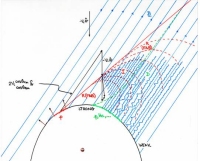Solar wind, bow shock and magnetopause
The session on solar wind and bow shock topics contained 14 presentations spread over three subsections. In the first section, processes and observations by the Cluster and THEMIS spacecraft in the solar wind and at the Earth bow shock were discussed. Two invited talks outlined the current issues, puzzles, and processes in the foreshock region and at the Earth's bow shock. One of the invited talks focused on theory and observations while the second talk addressed the current status of global hybrid simulations related to bow shock processes.
 |
|
Figure 1: Schematic drawing of the Earth's bow shock (Courtesy of Marty Lee) |
Contributed talks discussed the following science questions: the origin of Field-Aligned ion Beams (FABs), the generation of upstream Ultra-Low Frequency (ULF) and mono-chromatic waves, the origin of upstream measured spectra, upstream pulsations such as Short Large Amplitude Magnetic Structures (SLAMS) and 30 second waves. Because of the "small scale" of the Earth's bow shock, a clean separation into a quasi-parallel and a quasi-perpendicular part of the Earth’s bow shock is not possible and one part of the bow shock affects the other. This explains partly the complexity of the observations. Figure 1 shows a schematic drawing of the Earth’s bow shock with some of the main features and areas of interest discussed at the workshop.
The local structure of the Earth's bow shock was addressed in several talks. The main subject here was how the shock ripples or surface waves may impact the energy spectrum of the FABs. Attempts were made to use those FABs to remote sense the local structure of the Earth’s bow shock. Observations also showed that this non-stationarity of the Earth’s bow shock might also have an impact on downstream thermalization.
A series of talks addressed the topic of how upstream interplanetary structures, such as shocks or Tangential Discontinuities (TD), impact the location of the Earth's bow shock, the magnetosheath, and the magnetopause. The evolution of waves in the magnetosheath when a TD with a pressure rise impacts the bow shock was observed. The interaction led to a fast shock propagating into the magnetosheath ahead of the TD. A slow shock and a rarefaction wave were also observed.
The session showed that in terms of processes in the foreshock region and at the Earth's bow shock THEMIS can contribute a lot. Combining these two data sets is extremely important in order to improve our current knowledge of the physical processes in those regions. We have just begun to combine the two data sets and it looks very promising. There is a lot of very interesting work ahead.

